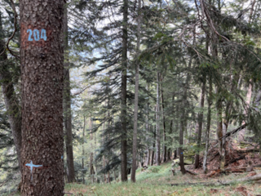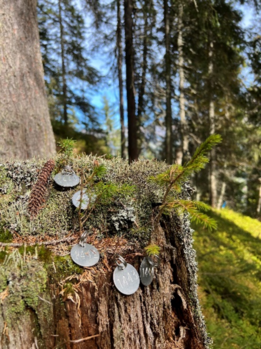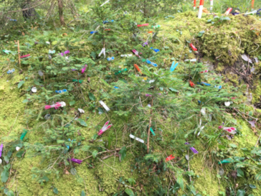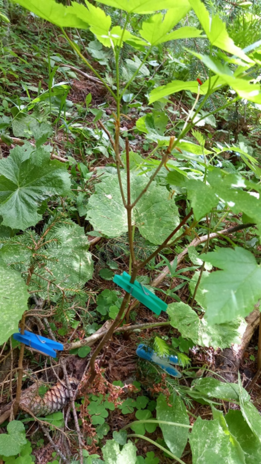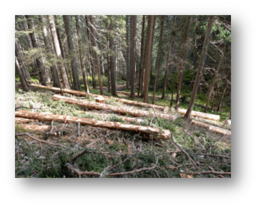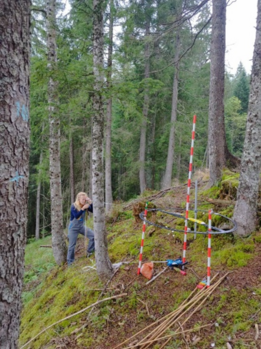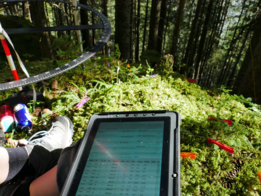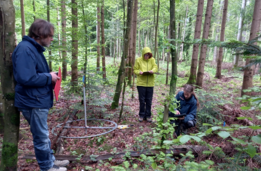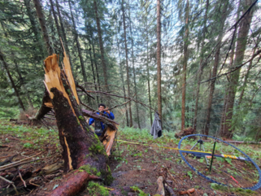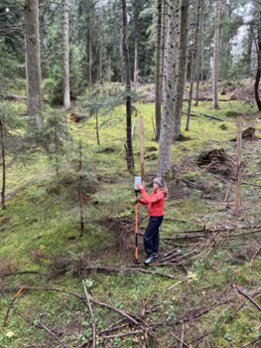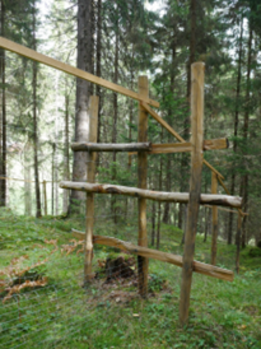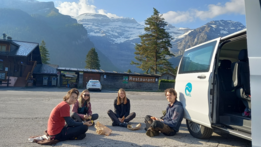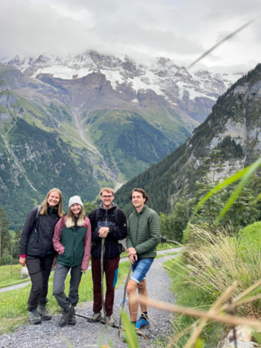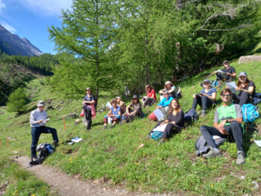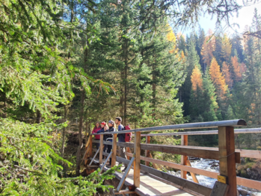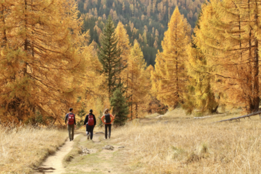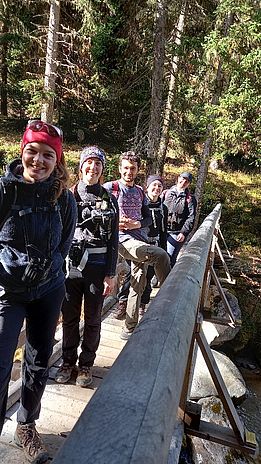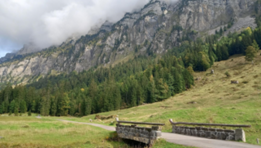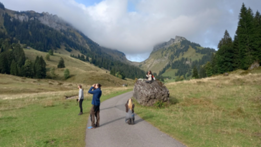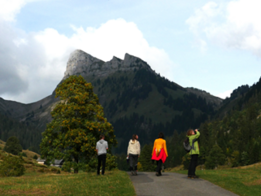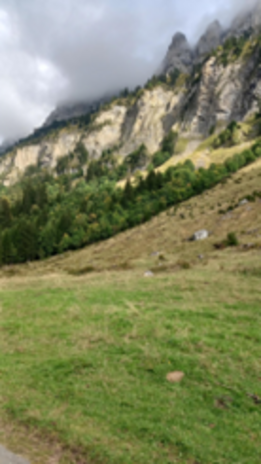Sustainable mountain forest regeneration
2020 - 2025
FinancingImproved basis for assessing and more targeted regeneration management in mountain forests ¶
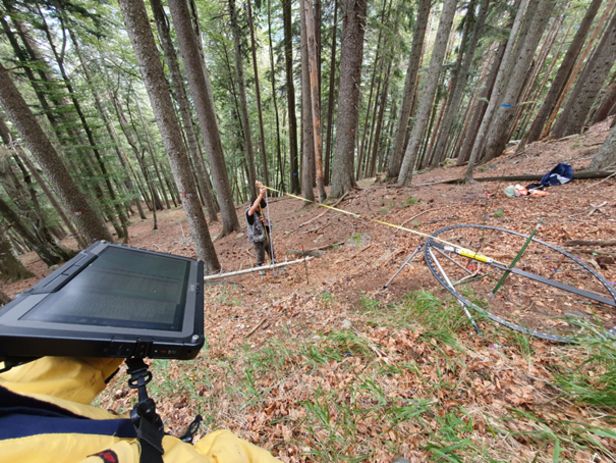
The aim of the "Mountain forest regeneration" project is to create a scientific and technical basis for the long-term and sustainable promotion of natural regeneration in mountain forests through silviculture. Long-term silvicultural experiments have been started on ten experimental sites in spruce-fir forests and results on the development of natural regeneration will be obtained from repeated inventories of the stand and regeneration. We will also assess how environmental changes, including climate change, affect natural regeneration. It is essential to maintain the protective effect of mountain forests, e.g. against natural hazards, which is significantly influenced by the density of regeneration and the stocking of the stand. Ultimately, practical tools for evaluating natural regeneration are to be created, among other things.
Contents ¶
Current ¶
All ten experimental sites have been established and the first major regeneration inventory (initial state) as well as the silvicultural interventions have been carried out everywhere. In 2024, the fences will be positioned at the two remaining experimental sites. The inventory of regeneration following silvicultural interventions was completed in seven out of ten experimental sites in summer 2023. The main aim of this inventory is to understand the extent of mortality and damage to the natural regeneration resulting from logging. In the summer of 2023, the second major regeneration inventory (exactly one year after the intervention inventory) was carried out at three of the ten experimental sites. This monitoring of regeneration density, of degree of cover of regeneration and ground vegetation, demographic development of individual regeneration plants and of microsite conditions including soil and light will be continued in 2024 and 2025. At the same time, damages to the regeneration including browsing intensity are being recorded. We are looking forward to the first results in the coming winter months (2023-2024). In the summer of 2024, the information obtained will provide initial insights into the short-term effects of silvicultural interventions on natural regeneration in mountain forests.
Motivation ¶
Today's forest regeneration is the key to tomorrow's forest services. Regeneration dynamics are extremely variable in time and space (stem numbers can range from less than 500 ha-1 to well over 100,000 ha-1) which leads to large differences in regeneration density among tree species and size classes. Therefore, regeneration stocks are difficult to assess, and their quantification requires profound knowledge of the prevailing regeneration processes as well of potential influencing factors. These include various threats from adverse weather conditions (e.g., wet snow, drought), pathogens (e.g., snow mould) and wildlife (especially browsing ungulates). Since these influencing factors interact strongly and often have an impact on regeneration processes over decades, they make it difficult to reliably assess forest regeneration.
In recent decades, great progress has been made in important areas of mountain forest management, for example when assessing the protective effect of stand structures. However, there are still large gaps in knowledge regarding regeneration processes due to the major challenges in selecting and recording key parameters that accurately reflect regeneration dynamics. In addition, it is difficult to estimate how regeneration will develop, as both the mortality of individual plants and additional seeding can be subject to extreme fluctuations. This is especially problematic as sufficient, diverse forest regeneration is very often a decisive factor in the management of mountain forests and creates the basis for the forest of the future.
Project goals and research questions ¶
The long-term project goals (time horizon 2025-2030) are to:
- Create a scientific and technical basis so that natural regeneration can be effectively promoted through silviculture. In the long term, regeneration plants should become forest stands that conform to targets and provide important forest services (focus on protection forest).
- Clarify how climate change affects regeneration development. For example, in dry summers, seedlings and saplings of drought-sensitive tree species could be affected by increased mortality, or natural regeneration of tree species from lower elevations could become increasingly established.
- Elaborate a "Practical Guide to Assessing Natural Regeneration". This methodological guide should provide information on natural regeneration at the stand level that is meaningful, technically sound, and therefore comprehensible and robust (reproducible). An important application of this information is silvicultural decision-making in the NaiS framework (Sustainability and Success Control in Protection Forests).
The project focuses on spruce-fir forests. However, the project results are likely to be relevant for other forest types as well.
For the creation of the technical bases, we will determine:
- The demographic dynamics (long-term development of tree populations) of natural regeneration in mountain forests.
- The influence and relative importance of factors (site, stand, disturbances) that are important for natural regeneration (demographic development, stem numbers, size distribution, height increment, tree species composition).
In addition, accompanying studies on sub-processes are planned that will improve the mechanistic understanding of regeneration processes in mountain forests.
Experimental sites ¶
A total of ten experimental sites were established in the Swiss Alps (Table 1 and Figure 2). Important criteria for site selection were:
- homogeneity within each site with respect to stand structure, relief, aspect and site type;
- tree species composition: good representation of Norway spruce and silver fir in the regeneration pool, and a gradient in the proportion of silver fir in the mature stand;
- environmental/site gradient: the main site types in fir-spruce forests were considered including differences in elevation and aspect. Experimental sites in the continental Central Alps were deliberately avoided because fir trees are only rarely found there.
All experimental sites are 1.1-1.5 ha in size, established as growth and yield plots (dbh threshold: 4 cm) and are contractually secured as long-term research plots.
Table 1: Characterisation of the experimental sites. Site types according to ARGE Frehner M, Dionea SA and IWA –Wald und Landschaft AG 2020: NaiS-NFI – Allocation of NFI-sampling plots to site types. Final report. Mandated by the Federal Office of the Environment BAFU, 68 p.
Community (Canton) | Elevation | Aspect | Site type (will be checked) | Silver fir proportion (estimate, %) |
Albula (Grisons) | 1300 | N | 53*Ta | 0 |
Flüelen (Uri) | 1485 | NW | 50 + 57C | 18 |
Lauterbrunnen (Bern) | 1495 | O | 46 | 0/scattered |
Ormont-Dessus (Vaud) | 1480 | NW | 50(49) | 30 |
Pfäfers (St. Gall) | 1530 | W | 51(60*) + 50(50*) | 20 |
Rougemont (Vaud) | 1600 | NW | 50 | 2 |
Sagogn (Grisons) | 860 | NO | 52F | 10 |
Visp (Valais) | 1120 | N | 55*Ta | 98 |
Wildhaus-Alt St. Johann (St. Gall) | 1365 | N | 50 | 0/scattered |
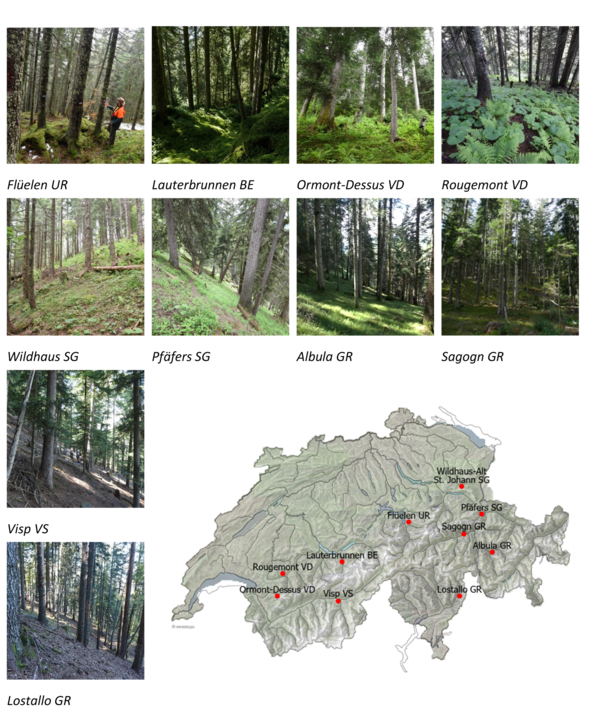
Study design ¶
The study design allows for long-term observations of regeneration populations along site gradients. For this purpose, ten experimental sites (case studies) were specifically selected and silvicultural interventions (three treatments) were carried out in order to increase existing gradients of light availability. The design enables the assment of the development of regeneration populations with a statistically meaningful number of plants under different environmental conditions. The effects of targeted silvicultural treatments on the development of microsite conditions (especially ground vegetation) and regeneration patterns will be examined and quantified.
- In phase I, the initial condition of the forest stand (stand structure, regeneration) of the ten experimental sites is recorded.
- In phase II, each experimental site is divided into three sub-sites for different silvicultural interventions: In the first sub-site, no intervention takes place (control), in the second sub-site, a weak intervention is carried out (removal of about 15-20% of the growing stock) and in the third sub-site, a strong intervention take place (removal of about 25-30% of the growing stock). To investigate the influence of wild ungulates on regeneration, four deer-proof fences (height 2 m) are installed in each sub-site.
- In phase III, the regeneration inventory is repeated at the experimental sites based on a 3-years cycle.
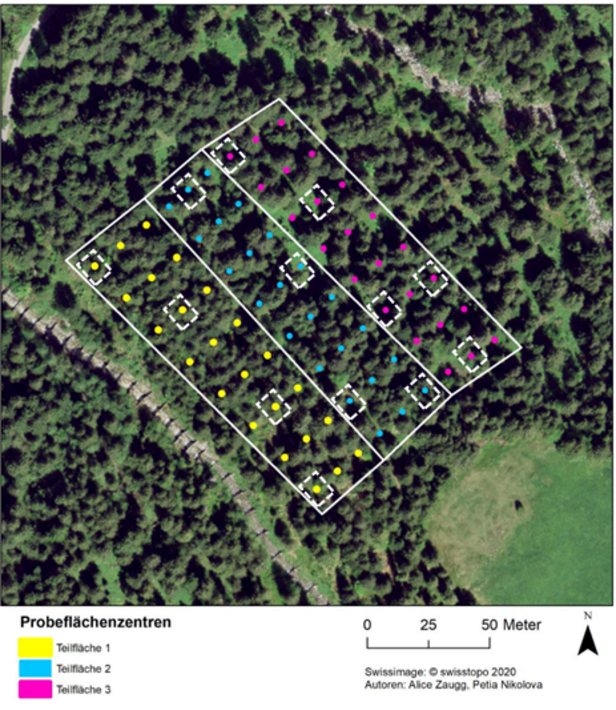
Regeneration inventory ¶
Regeneration processes are monitored in approximately 500 plots, i.e., 36-54 plots per experimental site. One plot consists of three concentric circular rings (Figure 4): 10 m2 for regeneration plants in size class 1 (1 year old to 9.9 cm tree height, germinants are not recorded), 20 m2 for size class 2 (10 to 39.9 cm tree height), and 50 m2 for size class 3 (40 to 129 cm tree height) as well size class 4 (130 cm height to dbh, diameter at breast height, of 3.9 cm). The inner circle around the plot center (radius = 60 cm) is not recorded. The exact position of each regeneration plant is measured using an azimuth ring (Figure 5 and Figure 6). The regeneration inventory consists of three parts:
- recording of microsite characteristics (relief and vegetation) and regeneration presence at 12 points (green dots in Fig. 4)
- recording and marking of regeneration individuals, including their microsite and their development (mortality, plant height) with a focus on the 1st quadrant
- counting the number of regeneration plants per species and size class in the concentric plot circles
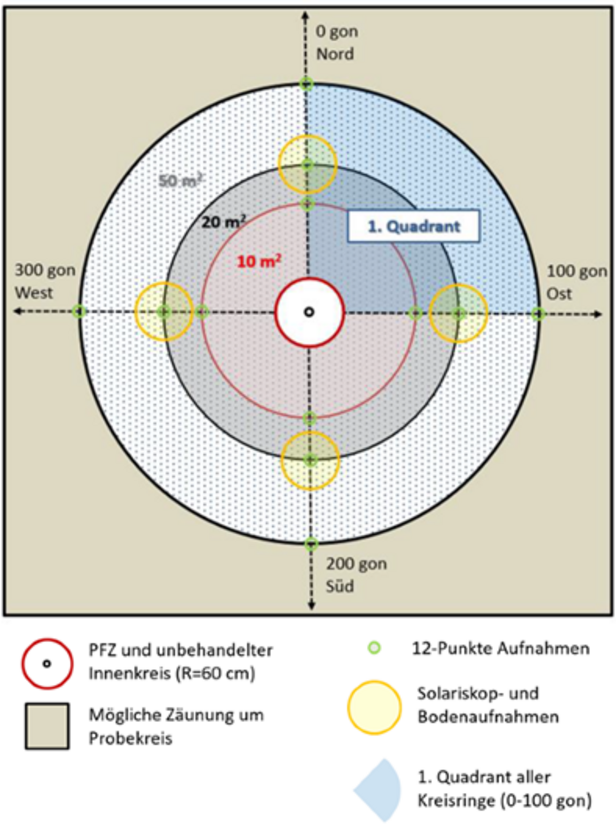
In addition, the thickness of the organic layer, humus type and light conditions are determined at four points per plot (yellow circles in Fig. 4) using a solariscope (Behling engineering, Hermannsburg, Germany).
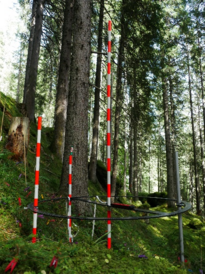
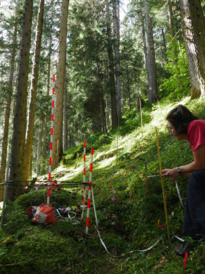
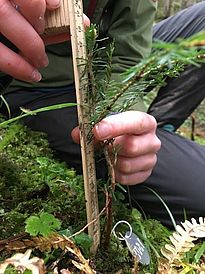
Topics for student theses are advertised every year and several internship positions are offered during the summer months.
Images ¶
Fieldwork ¶
Being together ¶
Excursions ¶
Fotos: L. Scheele, C. Spori, E. Hartmann, F. Fürst, P. Nikolova, R. Schai
Further cooperation partners ¶
Completed student theses ¶
Eggenberger, Nicole (2022): Ökologie im Gebirgswald – wie viel Licht braucht die (Ko-)Existenz? Bachelorarbeit. Wädenswil/Birmensdorf: Zürcher Hochschule für Angewandte Wissenschaften/Eidgenössische Forschungsanstalt WSL, 32 S.
Fox, Felix (2021): Bestimmende Faktoren für die Weiß-Tannen- (Abies alba), Fichten- (Picea abies) und Vogelbeeren- (Sorbus aucuparia) Naturverjüngung im Gebirgswald der Gemeinde Flüelen, Kanton Uri, Schweiz. Bachelorarbeit. Hochschule für Forstwirtschaft, Rottenburg, Deutschland. 86 S.
Probst, Tamara (2022): Abhängigkeit der Naturverjüngung von Tanne (Abies alba) und Fichte (Picea abies) von lokalen Umweltfaktoren in Tannen-Fichtenwäldern. Masterarbeit. D-USYS, ETH Zürich, 60 S.
Publications and reports ¶
Ambs D, Schmied G, Zlatanov T, Kienlein S, Pretzsch H, Nikolova PS, 2024. Regeneration dynamics in mixed mountain forests at their natural geographical distribution range in the Western Rhodopes. Forest Ecology and Management 552, doi.org/10.1016/j.foreco.2023.121550
Kalt T, Nikolova P, Ginzler C, Bebi P, Edelkraut K, Brang P, 2021. Kurzes Zeitfenster für die Fichtennaturverjüngung in Gebirgsnadelwäldern, Schweiz Z Forstwes 172: 156-165
Zaugg A, Lässig A, Nikolova P, Brang P, 2020. Projekt Gebirgswaldverjüngung: Dokumentation der Flächenauswahl. Interner Bericht. Birmensdorf, Eidg. Forschungsanstalt WSL, 9 S. + Anhang.
Brang P, Nikolova P, Gordon R, Zürcher S, 2017. Auswirkungen grosser Verjüngungslücken im Gebirgswald auf Verjüngung und Holzzuwachs. Schlussbericht des Projektes Eingriffsstärke und Holzzuwachs im Gebirgswald. Birmensdorf, Eidgenössische Forschungsanstalt WSL. 48 p.
